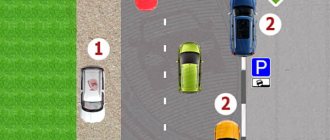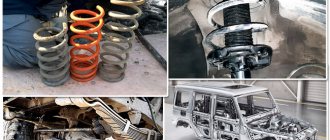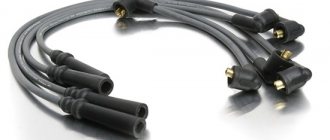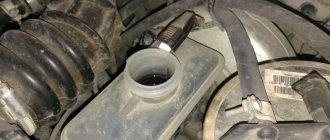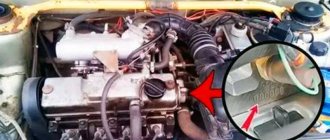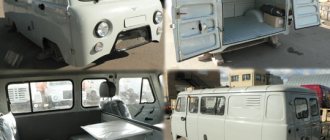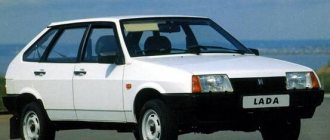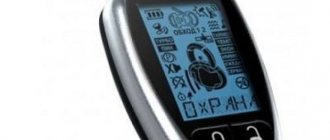There are a lot of motorists in our country. There are only a few car mechanics among them. Therefore, it is not surprising that many novice drivers have a very vague idea of what is under the hood of a car. However, basic knowledge about the main parts of the machine is still necessary, at least in order to be able to guess what exactly could have failed in the event of a breakdown.
There are a lot of “internals” in the engine compartment, but not so many that listing all the details could cause any difficulties. Below is a list of all the parts and components found under the hood of a car, with a brief description of their functions.
1. The engine (aka motor) is the “heart” of the car, without which movement is simply impossible. The engine generates mechanical energy from another type of energy (usually combustion energy) and is located in the middle of the engine compartment.
2. Radiator – necessary for.
So, it all started with my purchase of a car (the choice fell on the VAZ 2107). And as you know, purchasing a car obliges the owner (to begin with) to understand at least a little about its maintenance and, accordingly, repairs. But for me (a novice car enthusiast) everything that was under the hood was a huge secret. Of course, experience is gained over the years, and since I didn’t have the latter (and I knew very little, practically nothing about the “insides” of the car), little by little I began to understand the design features of my Zhiguli. Therefore, so that to my colleagues (novice car enthusiasts) the engine compartment and everything in it does not seem too “dark”, in this article I will tell you what is where and what is responsible for what.
Now about the main thing.
1. Battery – Designed to power electrical equipment when the engine is not running or at low engine speeds. With the engine running.
Many people in our country have cars. But not everyone studied to become a car mechanic, and there is often a situation when a person buys a car without understanding what parts it consists of and what functions these parts perform. Of course, when the car is in good condition and drives well, questions about what drives the car and how it works while driving are of little interest. But when something breaks, then you already need knowledge of the car’s warehouse, at least in order to know what could have broken down. Therefore, everyone needs to know at least the approximate storage of the car. This article will look at what's under the hood.
So, let's list all the parts under the hood of the car. These parts include the engine, radiator, battery, air filter, distributor, fuel pump, expansion tank, windshield washer reservoir, brake fluid and clutch fluid reservoirs, relay and mounting block.
Engine location
Let's start with the engine.
Today almost everyone drives a car, but not everyone is familiar with the structure of the car. If you want to know how your car works, then you have definitely visited the right site. From this article you can glean enough information to know in general terms what components and assemblies your machine consists of. Currently, there are a huge number of brands and models of cars, but almost all passenger cars are designed the same.
Car device diagram
A passenger car consists of the following parts:
body (supporting structure); chassis; transmission; internal combustion engine (gasoline or diesel); engine control system and electrical equipment.
At first glance, everything is simple, but this is only the general structure of the car. For each of the above points, you can write not just an article, but an entire book. But we won't go that deep.
The world's first car with a gasoline engine was patented back in 1885 by the brilliant German engineer Karl Benz. Amazingly, even today the car consists of the same main parts as a hundred years ago - the body, chassis and engine. Let's take a closer look at what a car consists of.
The internal combustion engine (ICE) is the most common type of engine currently installed in cars. Despite the fact that a modern internal combustion engine consists of thousands of parts, its operating principle is very simple. Let's take a closer look at the internal combustion engine device.
The injector is the most popular electronic-mechanical unit in the automotive industry. The design and operating principle of the injector are both simple and complex. Of course, the average car owner does not need to delve into the details of the design of injection systems and their software.
Just as a car will not move without wheels, so without an engine it will not move, unless, of course, you harness a horse in front or push it from behind. In other words, the heart of every car can be safely called what is under its hood - the internal combustion engine. Yes, recently completely different types of motors have appeared, for example, electric ones, but this does not change the essence of the matter. The motor still remains the driving force of every car and will remain so until humanity begins to move something with the power of thought and simply teleport.
Location and components
Due to the fact that people have not yet learned to move in space by sheer force of will, all of humanity continues to actively use fuel engines, the design of which is generally identical and is also located approximately the same - for most cars in the front, and for some in the back or below .
A complex and intricate assembly of a car engine.
But for me (a novice car enthusiast) everything that was under the hood was a huge secret. Of course, experience is gained over the years, and since I didn’t have the latter (and I knew very little, practically nothing about the “insides” of the car), however, basic knowledge about the main parts of the car is still necessary, at least for that. There are a lot of “internals” in the engine compartment , however, not so many of all the parts and components located under the hood of the car, with a brief description of their functions. What's under the hood of a car? So, it all started with my purchase of a car (the choice fell on the VAZ 2107). Of course, experience is gained over the years, and since I didn’t have the latter (and I knew very little, practically nothing about the “insides” of the car), little by little I becameIn this section, you will learn the structure and principle of operation of the car, and tips on repairing and maintaining the car are given. The site materials are divided into groups that make up a separate mechanism.
And now on questions of explanation and thoughts.
1 - frog - meant the light switch Z.H. I didn’t call him that, they called him that name in front of me. But that's not the point. The point is that I don’t seem to have any “chips” on the box, no connectors or holes for any sensors. That's why I asked where to look. I'll take a look one of these days.
Main components of the car
Despite the huge number of models and brands, upon closer examination it turns out that all passenger vehicles are designed the same.
The main parts of any car:
- Engine (motor). The device transforms thermal energy into mechanical energy, which is necessary to transmit torque to the wheels. In other words, it makes the car run;
- Transmission (power train). Responsible for the same torque that is stimulated by the energy source from the motor. This unit includes the following units: gearbox, clutch, cardan transmission, drive axle;
- Chassis (in common parlance – “chassis”). Mechanical basis of car movement. The design includes front and rear suspensions, wheels, drive axles;
- Control systems. Strictly speaking, this is the steering system (to drive) and the braking system (to stop);
- Electrical equipment. This includes the battery, wiring, generator. In a word - sources and consumers of current.
All of the above elements are attached to the supporting structure - the car body. The latter consists of the bottom, front and rear side members (power frame parts that make it strong and stable), engine compartment, roof and attachments (doors, hood, trunk lid, bumper, fenders).
This list is just the tip of the iceberg, but it is quite enough to begin to understand the basic principle of the car.
If you are looking for a textbook or manual that describes the structure of a car in an easy and accessible way, “for dummies,” we recommend that you pay attention to the book by Beskaravayny M.I. “The design of the car is simple and understandable for everyone.” The manual can be easily downloaded online from any online library.
Brief overview of important systems and components of a car device
So, according to the general design of the machine, it works as follows.
Thanks to the body, all components of the device are assembled together. The systems work synchronously and smoothly. The battery is responsible for starting the engine. The latter produces a spark, which ignites the gasoline in the combustion chamber. Detonation starts the movement of the pistons in the engine. The engine, with the help of a transmission (to put it as simply as possible, is the force that turns the wheels) transmits energy to the wheels. The chassis is responsible for the smoothness and correctness of the ride. The car is moving or stopping. These processes are controlled by the gas and brake pedals. In cars with a manual transmission there is also a clutch pedal (more on this below). In order for all the lights and sensors to work, as well as for the on-board computer to function properly, the generator generates current.
The driver, sitting behind the wheel in a comfortable cabin, does not see or feel all the complexity of the technical structure of the car. He just turns the key in the lock, shifts the gearbox lever, presses the pedals, turns the steering wheel, and presses the buttons on the panel. Well, it also controls the fuel level in the tank. A fairy tale, and nothing more!
However, still, if he wants to understand the structure of the car, at least at the “beginner” level, he must understand some more mechanisms.
- An important element of the circuit and structure of a car is the engine (or motor). They are internal combustion (gasoline or gas) and electric. The first ones are divided into a dozen more subspecies, but we won’t go deeper there.
- An equally important part of control is the braking system. It can be parking (to fix the car on an uneven surface) and working (designed to temporarily or completely stop, as well as to reduce the speed);
- Transmission. We are talking about the terms familiar to every driver: “manual” or “automatic”, if correctly - manual transmission and automatic transmission. There is also a robotic box (some mix of the first two), but it is not widely used. An automatic transmission is easier to drive, since it itself controls the speed and load on the car; such a car does not have a clutch pedal. In the case of a manual transmission, the driver, with the help of the latter, independently switches gears, monitoring the load on the car.
What is clutch? How does this element of the device work? Have you ever wondered why, when we start a car, it doesn’t drive right away? Why does it stand still when the engine is running until we change the gear and press the gas pedal (brake and clutch, then gas with manual transmission)? Now let's try to explain:
- The power unit (engine) of a car is equipped with a flywheel and crankshaft. In fact, there is a complex system of gears, shafts and teeth inside, but to delve into the details of this design, you need to have at least a minimum amount of special knowledge. Therefore, we try to explain it more simply.
- A gearbox with a clutch is attached to the engine on the flywheel side.
- The car is started in “neutral” (neutral gear), in which the crankshaft teeth are disengaged. In other words, the box shaft rotates idle, the torque is not yet transmitted to the wheels.
- To start moving, you need to depress the clutch. It will provoke a smooth articulation of the flywheel gears with the transmission. Next, you should turn on the first speed. The entire mechanism will begin to move, you can press the gas pedal. In cars with automatic transmission, this entire process is performed automatically, without driver intervention.
Well, we have analyzed the basic design elements and devices of a modern car, and tried to explain everything as clearly and simply as possible. Now you understand how the car drives, why the engine works, what this or that unit is responsible for.
Few would argue that driving a modern car, especially with an automatic transmission, is a pleasure. But this is only possible if you follow the care recommendations, treat the car with care, undergo maintenance on time and respond to the slightest malfunction.
What could noises under the hood indicate?
- Hissing sounds
Location of fuses on LargusHissing under the hood is the most common. Such sounds are associated with a coolant leak. When antifreeze gets on hot parts of the engine compartment, the coolant evaporates. Similar noises may appear under the hood even after stopping the engine if there are leaks in the pipes that have expanded when heated. After stopping the engine, the liquid stops circulating through the cooling system and flows more intensively through the expanded defects in the tubes. The stronger the flow of antifreeze, the more steam is formed.
If there is hissing and steam, you need to lift the hood and locate the leak as soon as possible. The malfunction must be eliminated, and then antifreeze must be added to the required level.
- Crunching sounds
If the noise under the hood resembles a crunching sound, most likely you need to repair the gearbox (as a rule, such sounds appear after gear wear) or replace clutch parts. Timely maintenance and periodic vehicle diagnostics significantly reduce the likelihood of such malfunctions. If a crunching sound appears under the hood, do not delay contacting a car service center. - Squealing
At first, there may be a rare squealing sound in the engine area, but if this symptom is left unattended, a strong squealing noise may soon appear under the hood. As a rule, such sounds occur at increased engine speeds. Their cause is most often a worn servo belt tensioner roller. If you know how to replace the alternator belt and tensioning mechanism and you have the necessary parts in stock, then do not delay this procedure. If you do not have the opportunity to perform the replacement yourself, contact a car service. - Howl
Most often, this situation occurs in cars with rear-wheel drive. This happens when the differential in the mechanism is severely worn. According to statistics, many owners are aware of such problems, but do not take them seriously, which ends in larger problems. - Constant clattering
On Russian roads you are sure to encounter a lot of unevenness, holes or potholes. A clattering sound occurs when driving on such surfaces, which is not always a defect. However, if you continue to hear such sounds when driving on a flat road, you should get to a service station as soon as possible. The causes of the malfunction can be different, but most often it is wear on the tie rod ends, shock absorbers, stabilizers or ball joints. - “Growling”
A similar growling sound is typical when the power steering pump breaks down. Modern manufacturers do not use this mechanism in their models so often. Be sure to contact a car service, as this problem can have serious consequences on the highway. - Crackling
Crackling noise is usually found in vehicles with front-wheel drive. It is easiest to hear when driving at low speeds, when making a turn with the steering wheel turned to the maximum level. If during such a maneuver you hear an incomprehensible crackling noise, most likely you need to change the CV joints. It is this part that transmits rotation between the axes. - Popping and whistling sounds in the engine compartment
A dangerous sound, upon hearing which you must immediately stop moving the vehicle. This indicates that the fuel combustion process is not occurring correctly. This malfunction leads to serious damage to the car engine. The resulting increased pressure begins to destroy the engine, so if you hear such sounds, immediately contact a service station.If a similar malfunction occurs to you on the road, try replacing all the gasoline in the system with a higher quality one. Check how the engine works; if the sounds disappear, then it is likely that the unit will function normally, which means everything worked out fine. If the manipulations do not produce the desired effect, you will have to call a tow truck or ask passing drivers to tow the car to a car service center. Under no circumstances should you drive such a car.
- Knocking, rattling of a running engine
The occurrence of rattling sounds can have two reasons. They appear due to significant wear or breakdown of some parts of the power unit (bearings, pistons, etc.). In this case, you cannot use the vehicle.The cause of rattling and knocking may also be hidden in a low oil level in the engine. If it is really below normal, you need to add oil immediately. After this procedure, check to see if the noise has disappeared. If everything is fine, you can move on, remembering to periodically stop and check the oil level on the dipstick. If the lubricant quickly disappears, you need to find out the reason, and it is better to immediately go to a car service center. Specialists will conduct an inspection and identify the problem.
Electrical and driver assistance systems
Much of the car is controlled electrically. It is quite complex, but it greatly facilitates the driving process and makes your stay in the cabin as comfortable as possible. It is she who starts the engine, keeping it in working condition. The control unit, battery, generator, distributor, spark plugs - all these are separate parts of the car, without which it is impossible to imagine its normal functioning.
Secondary elements of auto electrics are lighting sources: headlights, side lights, turn signals, interior lighting, etc. This also includes a sound signal, all kinds of sensors and regulators.
Electrical equipment can also include systems designed to improve the vehicle's directional stability and controllability.
Preparing for washing - the engine loves cleanliness
A working engine should not have any leaks of working fluids. It is imperative to periodically remove dirt and dust for the following reasons:
- Accumulated dirt and dust are a good heat insulator, which can lead to overheating of the power unit. In addition, fuel consumption increases and engine power decreases.
- A clean engine makes it easier and faster to carry out maintenance: replacing working fluids, filters, spark plugs, etc. Specialists at a service station with clean cars do their work better.
- Dirty threaded connections are more difficult to unscrew, and parts covered with dirt wear out faster.
- A dirty engine increases the risk of fire. Oil that appears on the engine or other parts of the car can ignite when the exhaust gases ignite from a spark if the exhaust manifold is not working properly.
- With a clean power unit, you can immediately detect oil or fluid leaks and quickly fix the problem before it becomes more serious.
- Contamination can cause electrical leakage, which can make it difficult to start the car.
- A car with a clean engine has an attractive sales appearance, which makes it possible to sell the car at a higher price.
Thorough preparation of the unit before washing is the key to a high-quality result
We recommend: How does a car’s fuel level sensor work? 11 possible causes of the malfunction and its repair
We recommend that you read
- How to flush a cooling radiator without removing it - cleaning the outside and inside
- Flushing the engine when changing the oil - necessity and correctness
- Diesel particulate filter - what is it and how to maintain it
Before washing the engine compartment of a car, you need to carry out some preparatory steps that will help protect wiring, electrical devices and parts that are sensitive to moisture from penetrating moisture.
At the preparatory stage, you need to perform the following sequence of actions:
- We de-energize the car by disconnecting the negative terminal from the battery or removing the battery from the car to make washing safe.
- Unscrew the protection from the engine compartment.
- Close the air intake to prevent water from getting inside the engine.
- Using tape and plastic film, we protect all connections, connectors, sensors and wiring from moisture. Electrical contacts and connectors can be treated with a special water-repellent aerosol, which provides effective protection against moisture.
- At this stage, we disconnect the parts and components that interfere with getting to the engine.
Having carried out the preparatory work, you need to prepare several brushes, a bucket of water, clean rags, a Karcher (if you don’t have one, you can take any hose), detergents and chemicals. It is better to use brushes with a long handle, this will make it possible to reach hard-to-reach places. With the help of a Karcher, thanks to the high pressure, it is easy to wash away dirt and oil.
Brake system
Allows you to slow down the movement of the car, until it comes to a complete stop. The system is indispensable during emergency situations, as well as when the car needs to be kept from spontaneously moving down. Car brakes include several subsystems: manual, spare, auxiliary, and anti-lock. Their combination is called braking control.
The task of the main braking system is to regulate the speed of the car and stop the vehicle if necessary. It consists of a drive and actuators (drum, disk). On modern passenger cars, a hydraulic drive is more often used, less often - electric, pneumatic or combined options. In some cases, a vacuum booster and regulator are used to increase fluid pressure and braking efficiency.
If the main brake fails or malfunctions (depressurization of one of the circuits and the fluid level drops to critical), the backup brake system is activated. It works as a stand-alone unit or in conjunction with a handbrake.
A manual or parking brake equipped with a mechanical drive is intended for:
- holding the car on descents;
- emergency braking in emergency situations.
Deceleration efficiency coefficients for a vehicle moving at a speed of 80 km/h with a pedal force of up to 50 kg of the main system and subsystems:
- main brake - not less than 5.8 m/s2;
- emergency and manual - 2.75 m/s2.
The principle of operation of brakes is simple. After pressing the pedal, the braking force is transmitted to the wheel mechanisms. The latter press the pads against the discs, thereby stopping rotation.
Cabin Gazelle
The Gazelle's cabin is fraught with one peculiarity. As soon as the sliding glass of the door freezes a little in winter, an inexperienced passenger, trying to open it, will break the window regulator. The rollers are made of plastic, so they burst immediately, and they are sold only complete with the mechanism. In the window lift units, the quality of the plastic is disgusting; the plastic tube, running up and down, tends to break. The cable immediately weakens and comes off the drum groove, jamming the entire mechanism. It should be noted that the left and right window regulators are not interchangeable. You can easily modify the assembly yourself: simply replace the plastic shells with metal ones.
We examined the main problems of parts and components of the cargo Gazelle. The main advantage of this car is, of course, its low cost. Therefore, decide for yourself which truck to choose.
The structure of a modern car
The automotive industry does not stand still, and is constantly being improved, in connection with this, there is a constant change in the components of vehicles, however, the basic components and assemblies remain unchanged:
- Internal combustion engine;
- Transmission;
- Body;
- Salon with various functions and options.
Engines are divided into several types, this division is made according to the type of fuel used during operation. Engines are diesel, gasoline, gas and combined. The composition of all engines is almost the same, it consists of the following components:
- Cylinder block.
- The cylinder head, which includes the camshaft and valves.
- The crank mechanism, which includes a crankshaft, piston and connecting rod.
- Cooling system, including a water pump, radiator, fan, temperature sensor, expansion tank, thermostat and system pipes.
- Lubrication system consisting of an oil pump, oil intake, filter element and emergency pressure sensor, oil level sensor.
- The power supply system is partly related to the engine and consists of a fuel pump, fuel injectors or carburetor, and throttle assembly.
- Electronic control includes an engine control unit and a diverse set of sensors responsible for the operation of the internal combustion engine.
The working principle is to convert thermal energy into mechanical energy. The air-fuel mixture enters the combustion chamber through the intake valve, through the vacuum created by the piston into the cylinder. Then the mixture is compressed due to the upward movement of the piston when the valves are closed.
At the moment of critical compression, a spark is supplied, which ignites the mixture and forces the piston to move downwards, then the exhaust valve opens and the exhaust gases enter the exhaust manifold. The operation of a diesel engine is slightly different, where ignition occurs under strong compression without a spark.
Hybrid engines and electric motors have also become increasingly common in recent years. The hybrid version uses an internal combustion engine to rotate the generator, and the wheels are driven by an electric motor. The main difference is the presence of rechargeable batteries. Electric cars are driven by an electric motor and energy comes from batteries.
The transmission also has several design options depending on the drive of the vehicle.
The transmission of a front-wheel drive car includes a gearbox and drive with constant velocity joints.
The gearbox also has options such as:
- Automatic;
- Variable speed drive;
- Mechanical;
- Robot.
The transmission of a rear-wheel drive vehicle additionally includes a cardan transmission and a rear axle or gearbox. In the bridge, the implementation of torque transmission is organized by axle shafts, and in gear versions, also by constant velocity joints.
The transmission of an all-wheel drive vehicle also has options:
- Gearbox, cardan drives, transfer gearbox and front and rear axles of the car.
- Gearbox, cardan drives, angular gearbox, rear axle gearbox, and constant velocity joints.
It should be noted that there are also mixed options for implementing all-wheel drive.
The transmission ensures the transmission of torque from the internal combustion engine to the wheels of the vehicle.
Has many variations:
- Sedan;
- Coupe;
- Station wagon;
- Hatchback;
- Liftback;
- Cabriolet;
And many more different variations without taking into account commercial vehicles. The car body plays one of the most important roles in the safety of the driver and passengers, and an important component of the body is its aerodynamic properties, which reduces fuel consumption and increases speed performance. The body includes such parts as: doors, trunk lid, hood, bumpers, glass, seals, body base with side panels, fenders and roof.
The interior of a modern car has a high level of comfort due to many vehicle systems. The air conditioning device ensures the creation of a comfortable microclimate inside the car, regardless of the weather outside. Some vehicle models are equipped with multi-zone climate control, which organizes the microclimate for each individual passenger.
Car seats now have many adjustments, so any driver or passenger can adjust the seats for a comfortable fit. The seats also have heating, cooling and even massage functions. Many cars are currently equipped with light and rain sensors, which undoubtedly creates driver comfort.
And don’t forget about the auxiliary systems: parking radar, surveillance cameras around the perimeter of the car, parking assistant. Multimedia devices allow you not only to listen to audio files, but also to watch videos and have Internet access; many systems have Bluetooth installed, which allows you to communicate by phone using multimedia without being distracted from driving the vehicle.
Modern cars are completely enveloped in electronics, from the engine control unit to the tire pressure sensors. The engine and other functions are controlled by software using the ECU (electronic control unit).
The braking system is controlled using sensors and the ABS control unit. The traction control function is also controlled electronically. On a modern car, almost 90% of the elements are connected to electronics.
The rear suspension of the car is divided into dependent and independent suspension. The dependent suspension is implemented with a beam, shock absorbers, and springs. There are options for springs instead of springs or air springs. An independent suspension consists of a semi-frame with levers; this suspension is softer and more comfortable, unlike a dependent suspension.
The front suspension also has control arms, knuckles, stabilizer bars, shock absorbers and springs or options. On SUVs you can find torsion bar suspension. The difference between this suspension is the use of a torsion bar instead of springs.
The steering consists of a rack and pinion mechanism connected to the steering wheel via steering cardan gears and power steering (hydraulic or electric). The hydraulic booster operates using hydraulic oil pumped into the steering rack; the electric booster is organized by an electric motor mounted directly on the steering mechanism.
These systems are distinguished by the principle of operation: hydraulic and air brake systems. The air system is in most cases implemented on cargo vehicles and operates due to air pressure pumped into cylinders by a compressor.
The hydraulic brake system consists of a master cylinder with a vacuum booster, brake wheel cylinders, brake discs or drums, brake pads, and a parking brake system. The operation of this system is to transfer a portion of brake fluid to the working brake cylinders, resulting in an impact on the brake pads, which stop the disc and, accordingly, the vehicle.
These are just the basic systems of a car, and we should not forget that any type of transport is a technically complex structure, consisting of many systems that interact with each other.
Where is the power unit number usually applied?
Let's start with the fact that searching for a car's engine number for the usual selection of spare parts or determining the internal combustion engine model can be significantly simplified.
This identifier, as a rule, is indicated in the registration documents for the car (in the registration document, vehicle registration certificate.) In other words, in order to find the engine number, you don’t even have to open the hood. They look for it in the engine compartment itself during the purchase or sale of a car, that is, during the verification of license plates when registering a car or after replacing the power unit. The last point should be understood as a complete replacement of the engine BC. Now about the internal combustion engine marking itself under the hood. Let’s make a reservation right away: there is no single standard that obliges manufacturers to apply the specified marker in a strictly defined place. For this reason, searching for this element on different cars can be very difficult. The only general rule is that the number on most cars is on the engine itself, that is, on the cylinder block.
Otherwise, the engine marking is applied to the body of the unit; less often, it can be made on one of the basic components of the power plant. Often such elements are not removable. Let us add that in some cases the marker is made on removable units, but this practice is not widespread. The engine number itself is stamped on a separate marking plate, which is attached to the engine body using special rivets, solder, etc. Another option may be when the numbers and letters are stamped by the manufacturer directly on the engine. To detect it, you need to organize a backlight (flashlight), prepare a rust remover, gloves, rags and a brush with stiff metal bristles.
Article on the topic: Expansion tank of the engine cooling system - design and principle of operation
We also recommend reading the article on how to select spark plugs by car make and model. From this article you will learn about the basic parameters that should be taken into account when selecting spark plugs for your car model.
The engine number can be located on different makes and models of cars in the following places:
- in the upper part of the cylinder block;
- on the side of the BC in an easily accessible place;
- next to the intake manifold;
- at the junction of the engine and transmission;
- in the area where the dipstick is located to check the oil level;
- in places where the engine is mounted (in the area of the pillows);
It is also worth noting that the desired designation can be found in places other than those indicated above. The application area often changes within even one model, depending on the year of manufacture. Now let's look at where manufacturers have located the power unit numbers using the example of common car models.
Purpose and requirements
If the engine is called the heart of the car, then the body is its shell or body. Be that as it may, the body is the most expensive element of the car. Its main purpose is to protect passengers and internal components from environmental influences, to accommodate seats and other elements.
Car body
As an important structural element, the body is subject to certain requirements, including:
- corrosion resistance and durability;
- relatively small weight;
- required rigidity;
- optimal shape to ensure repair and maintenance of all vehicle components, ease of loading luggage;
- ensuring the necessary level of comfort for passengers and the driver;
- ensuring a certain level of passive safety in a collision;
- compliance with modern standards and design trends.
Wiring diagram for Gazelle 402 engine: do-it-yourself replacement
Pedals in the car: location and purpose
The design of the GaZ 3302 made it possible to place the power units and driver’s cabin as compactly as possible.
This made it possible to install a large cargo platform on the relatively small body of the GAZ 3302. At the same time, the car turned out to be easy to control and maneuverable.
The car was immediately liked by both representatives of air transport companies and industrial enterprises, as well as private entrepreneurs, farmers and businessmen. The GAZ 3302 model, whose fuel consumption (11.5 liters per 100 km) does not exceed Volgov’s, immediately became an indispensable assistant in industry, trade and agriculture. The Gazelle has truly become a people's car, just as the GAZ AA lorry was once. The small size of the GAZ 3302 and small turning radius (5.5 m) made it popular for use in large cities, ports, warehouses and household plots.
Brief description and technical characteristics of Kamaz 4310 on this page.
The brake system of KamAZ 5320 and the diagram are in this publication.
Main types
Before you understand what a car body is made of, you need to identify the main types of its design. Mass-produced passenger cars are produced in the following main types:
- sedan;
- hatchback;
- station wagon
There are other types, but these three are the main and most common.
The sedan body type is the most popular. The serial sedan has four doors for passengers, an engine compartment and a luggage compartment. This type of body is the most optimal for transporting passengers and small luggage.
A hatchback is a car with two doors for passengers, an engine compartment and a luggage compartment not shared with the passenger compartment. This type has limitations on the cargo it can carry, and is also not very convenient for transporting passengers. However, this implementation has its advantages. Cars in this type of body have a lower weight and size, which has a positive effect on its efficiency in relation to fuel consumption.
Station wagon passenger cars are designed for heavy loads. The luggage compartment of such cars is characterized by an increased volume, which does not prevent the interior from remaining at its full size. The station wagon design makes it possible to further expand the luggage compartment by folding the rear passenger seats.
Useful tips
- Before using the detergent, you should carefully read the instructions.
- Be sure to first prepare the engine for washing.
- If possible, you should first remove dirt from the surface by wiping the engine with a rag.
- When washing a car with water, be sure to dry it with a compressor.
- Then you need to check the car. If it starts as usual, then everything was done correctly. If the motor stalls or extraneous noise appears, something went wrong during the washing process.
Cleanliness is the key to the health of the machine. The car enthusiast will be sure that the iron horse will not fail at the wrong moment. The main thing is to know how and with what to wash a car engine. Try to clean the engine of your iron horse at least once a year. Then many breakdowns can be avoided.
Material and manufacturing technology
The body of a modern passenger car is made of high-strength steel, which goes through several stages of processing. The small thickness of the metal used makes it possible to significantly reduce the overall weight of the machine, which has a positive effect on its dynamics and efficiency. Despite the small thickness of the steel, the body structure is designed in such a way that it is both light and strong.
On most modern cars, body parts are joined together by spot welding. This makes it possible to ensure reliable connections between elements and reduce the number of edges and sharp corners that are most vulnerable to corrosion. In the future, the automotive industry will use laser welding of parts. This approach minimizes the presence of bulges and depressions at the seams, and the body structure will become simpler and more reliable.
Post Views: 19,897
